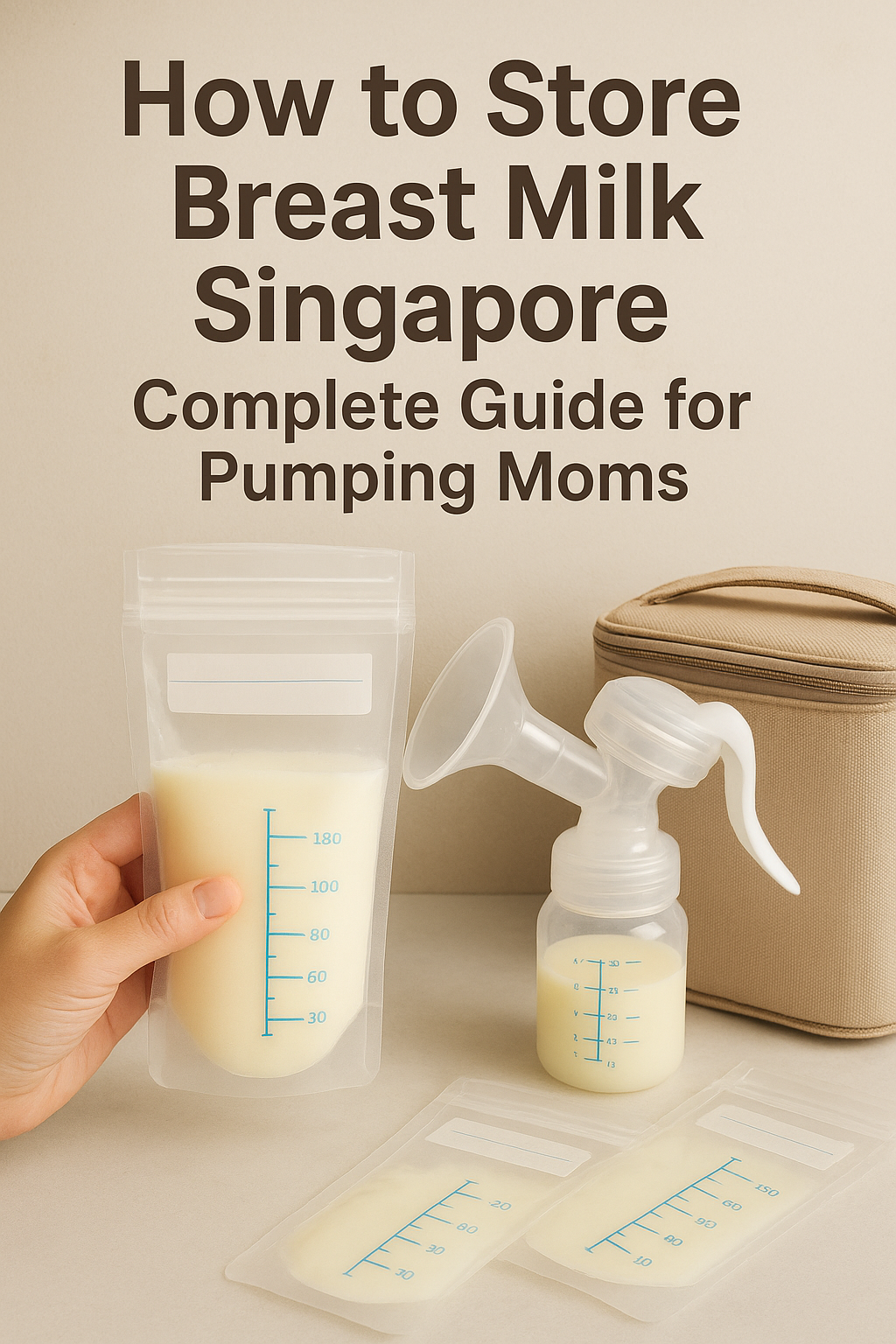
How to Store Breast Milk Singapore: Complete Guide for Pumping Moms
Share
Breast milk is nature’s perfect nutrition for babies, providing essential nutrients and antibodies that support growth and immunity. For moms in Singapore, balancing work, life, and breastfeeding can be challenging, which makes understanding how to store breast milk Singapore properly extremely important. Proper storage ensures milk remains safe, nutritious, and ready for your baby whenever needed.
This comprehensive guide will cover everything from local storage guidelines, selecting the right baby milk freezer Singapore, to best practices for pumping moms. Whether you are new to breastfeeding or looking for better storage strategies, these tips will make your milk storage process easier and safer.
Why Proper Breast Milk Storage Matters in Singapore
Breast milk is sensitive to temperature and handling. Incorrect storage can lead to bacterial growth, nutrient loss, or spoilage. In Singapore’s warm climate, it is crucial to follow local storage guidelines to keep milk fresh.
Benefits of proper storage include:
-
Maintaining nutritional quality and antibodies
-
Preventing spoilage and wastage
- Ensuring the baby always has safe milk available
Understanding Local Breast Milk Storage Guidelines in Singapore
Singapore’s health authorities recommend specific storage durations for breast milk depending on the storage method:
|
Storage Method |
Temperature |
Recommended Duration |
|
Room temperature (25°C or below) |
Up to 4 hours |
|
|
Refrigerator (4°C) |
Up to 4 days |
|
|
Freezer (-18°C or below) |
6 to 12 months |
Always monitor your fridge and freezer temperatures to ensure milk stays safe. Avoid leaving milk in areas exposed to sunlight or fluctuating temperatures. Using a thermometer can help maintain consistent storage conditions.
Choosing the Right Storage Containers and Bags
Selecting the right storage containers is critical for maintaining milk quality. Options include:
-
Breast milk storage bags: Space-efficient, pre-sterilized, and perfect for freezing.
-
Glass or BPA-free plastic bottles: Ideal for short-term refrigeration.
Tips for safe storage:
-
Label each container with the date and time of expression.
-
Leave 1–2 cm of space at the top for expansion during freezing.
-
Use containers designed specifically for breast milk.
For guidance on freezing and organizing milk, see Breast Milk Freezer.
Freezing Breast Milk in Singapore
Freezing is one of the safest methods for long-term storage of breast milk. Freezing tips for moms in Singapore include:
-
Freeze milk in small portions (2–4 ounces) to minimize waste.
-
Allow freshly expressed milk to cool in the fridge before freezing.
-
Lay bags flat for faster freezing; once solid, store upright to save space.
-
Avoid freezing milk in the freezer door due to temperature fluctuations.
For moms looking for modern storage options, Freeze-Dried Breast Milk Powder offers long-term storage without the need for a freezer.
Thawing Breast Milk Safely
Proper thawing ensures that nutrients are retained:
-
Move frozen milk to the refrigerator and allow it to thaw overnight.
-
For faster thawing, place the sealed bag in a bowl of warm water.
-
Swirl gently to mix fat layers; avoid vigorous shaking.
-
Always check the temperature before feeding.
Understanding Milk Shelf Life
Knowing how long milk can be safely stored is essential to prevent wastage and ensure your baby’s health. Different storage methods have different shelf lives:
-
Room temperature: Up to 4 hours. Ideal for freshly expressed milk when feeding immediately. Avoid leaving milk in hot or humid areas, as Singapore’s climate can accelerate spoilage.
-
Refrigerator (4°C): Up to 4 days. Store milk in the main compartment, not in the door, to maintain a stable temperature. Using labeled storage bags can help you manage milk rotation efficiently. You can learn more about proper fridge storage at Breast Milk Storage.
-
Freezer (-18°C or below): 6–12 months, though 6 months is ideal for maintaining nutrient quality. For long-term storage, a dedicated baby milk freezer Singapore is recommended, as it holds a consistent temperature and prevents spoilage.
Rotation tip: Always follow the “first in, first out” principle. Place older milk in front for easy access, and newer milk at the back. This helps avoid accidental spoilage and ensures milk is used at its freshest.
Identifying Spoiled Milk
Even with careful storage, breast milk can go bad if stored improperly. Signs to watch for include:
-
Sour or rancid smell
-
Discolored or clumpy texture
-
Fat separation that doesn’t mix after gentle swirling
Sometimes milk may have a soapy or metallic taste caused by natural enzymes like lipase. While this is not harmful, some babies may refuse it. For more information, see Breast Milk Metallic Taste.
Tip for moms: Smell and taste are usually reliable indicators, but if you’re ever unsure, it’s safer to discard the milk than risk feeding spoiled milk.
Organizing Milk for Busy Pumping Moms
Effective organization is key for pumping moms managing multiple storage containers:
-
Label containers clearly: Include the date, time, and baby’s name for easy identification.
-
Use bins or trays by date: Store older milk at the front to ensure it is used first.
-
Track usage with a Baby Milk Calculator: Helps you plan portions and prevents running out of milk unexpectedly. You can check out Baby Milk Calculator for easy tracking.
Moms can combine these strategies with consistent pumping schedules to maintain a reliable milk supply while avoiding waste.
Boosting Supply While Storing Milk
A steady supply of breast milk is crucial for storage. Some practical strategies include:
-
Stay hydrated and nourished: Drink plenty of water and consume lactation-friendly foods to support milk production. For more ideas, see Food to Increase Breast Milk.
-
Follow a consistent pumping schedule: Pumping at the same time each day can help stimulate supply.
-
Consider natural supplements: Some mothers use galactagogues or lactation teas to support production. For safe beverage options, refer to What to Drink to Increase Breast Milk Naturally.
Maintaining both supply and storage ensures that milk is available for your baby when needed, whether at home or on the go.
Breast Milk vs Formula
Breast milk contains live antibodies, enzymes, and nutrients uniquely tailored for your baby. While formula can provide adequate nutrition when breast milk is unavailable, it does not offer the same immune benefits.
Proper storage techniques ensure that breast milk retains its nutritional advantages longer than formula. For a detailed comparison, visit Breast Milk vs Formula.
Travel and Breast Milk Storage Tips in Singapore
Moms who travel or commute often need to keep milk safe outside the home. Here are some effective strategies:
-
Use insulated coolers with ice packs: Helps maintain the correct temperature during transit.
-
Divide milk into small portions: Makes thawing and feeding easier while reducing waste.
-
Avoid direct sunlight: Keep milk in a shaded area to prevent spoilage.
-
Plan storage: For long trips, consider combining refrigerated storage with a portable baby milk freezer Singapore if feasible.
Freeze-Drying for Long-Term Storage
Freeze-drying transforms milk into powder while preserving nutrients. Benefits include:
-
Shelf-stable for years, ideal for travel or emergencies
-
Maintains antibodies and enzymes
-
Convenient for busy schedules
Conclusion
Proper storage of breast milk in Singapore ensures that babies receive safe, nutritious milk while helping pumping moms manage their schedules. Following local storage guidelines, using the right containers, maintaining baby milk freezers Singapore, and knowing how to freeze and thaw milk safely will reduce wastage and preserve nutrients.
Modern solutions like freeze-dried breast milk powder also make storage and travel more convenient. With these tips, moms can confidently store, organize, and feed breast milk while maintaining their supply and supporting their baby’s growth.
Frequently Asked Questions
-
Can I store breast milk at room temperature at work?
Freshly expressed milk can stay at room temperature for up to 4 hours. For longer periods, refrigerate or use a cooler with ice packs.
-
How do I transport breast milk safely during a commute?
Use insulated coolers with ice packs and small portioned containers to maintain cold temperatures and prevent spillage.
-
How often should I pump at work?
Aim to pump every 3–4 hours, adjusting for your milk supply and work schedule.
-
Can I mix milk from different workdays?
No, only combine milk pumped within the same 24-hour period after cooling both batches to the same temperature.
-
Is it okay to use freeze-dried breast milk at work?
Yes, it’s a safe and convenient backup when refrigeration isn’t available. Simply reconstitute it with warm water before feeding.
-
How do I maintain milk supply while at work?
Stay hydrated, eat lactation-friendly foods, and stick to a consistent pumping schedule.
-
Can I store milk in a shared fridge at work?
Yes, but ensure your milk is sealed in labeled containers and placed in the coldest section of the fridge.
-
What is the best container for travel milk storage?
Fat naturally rises to the top in stored breast milk. This is normal and safe. Simply swirl gently to mix before feeding, but avoid shaking as this can damage nutrients.
-
Can I warm breast milk twice?
No, reheating milk more than once increases the risk of bacterial contamination. Only warm the amount your baby will consume at one feeding.
-
What temperature should the milk be for feeding?
Use BPA-free bottles or freezer-safe storage bags, preferably in small portions for convenience.
